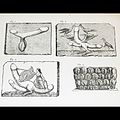Category:Ancient Roman Tintinnabula
Jump to navigation
Jump to search
Italiano: Il Tintinnabulum fa parte del mondo magico e superstizioso degli antichi Romani. Si caratterizza per una forma fallica, generalmente in bronzo, sospesa ad una catenella e provvista di diversi campanelli. Esso veniva appeso agli ingressi delle case e delle botteghe con lo scopo di favorire ed attrarre la buona fortuna, di scacciare il malocchio e soprattutto di neutralizzare lo sguardo malevolo ed invidioso che, attratto dalla forma fallica, finiva per colpire l'amuleto e non l'oggetto dell'invidia. Il tintinnabulum acquista così le più diverse e fantasiose forme, talora anche caricaturali, poiché anche il ridere scaccia il male. Esso è equivalente nel suo potere magico e nell'effetto alla semplice forma del fallo (amuleto chiamato in antico fascinum), che si incontra frequentemente rappresentato sulle pareti delle case e lungo le strade delle città romane (per esempio a Pompeii) con lo stesso scopo. Una interessante e divertente collezione di tintinnabuli è esposta nel Gabinetto Segreto del Museo Archeologico Nazionale di Napoli.
English: The tintinnabulum is part of the magic and superstitious world of the ancient Romans. It is characterized by a phallic form, usually in bronze, suspended by a chain and supply of various bells. It was hung at the entrances of houses and shops with the aim to promote and attract good luck, ward off the evil eye, and especially to neutralize malicious and envious eyes that, attracted by the phallic form, ended up hitting the amulet and not the object of envy. The tintinnabulum acquires so the most varied and fantastic shapes, sometimes grotesque, because even the laughter drives away evil. It is equivalent in its magical power and effect to the mere form of the phallus (amulet in ancient times called fascinum), which is often found represented on the walls of the houses and streets of Roman cities (for example at Pompeii) for the same purpose. A collection of interesting and fun tintinnabuli is exposed in the Secret Cabinet of the National Archaeological Museum in Naples.
Deutsch: Das Tintinnabulum war in der Antike ein metallenes Glöckchen oder eine Schelle, meist aus Bronze, aber auch aus Eisen sowie Gold und Silber. Tintinnabula hatten unterschiedliche Größen und Formen, unter denen die an Phalloi hängenden Tintinnabula eine eigene Gruppe bilden. Ihr übelabwehrender Lärm spielte als Apotropaion im Kult eine Rolle. Die Glöcken konnten mit Inschriften versehen oder mit kleinen Reliefs verziert sein. Das Tintinnabulum fand vielfältigen Einsatz im alltäglichen Leben und zeigte etwa die Öffnung des Marktes oder der Thermen an. Sklaven wurden mit ihm geweckt, Nachtwachen wurden damit auf die Probe gestellt.
wind chime | |||||
| Upload media | |||||
| Subclass of | |||||
|---|---|---|---|---|---|
| Part of | |||||
| Different from | |||||
| |||||
Subcategories
This category has the following 5 subcategories, out of 5 total.
B
Media in category "Ancient Roman Tintinnabula"
The following 15 files are in this category, out of 15 total.
-
A collection of figures depicting phallic motifs. Etching. Wellcome V0038934.jpg 2,150 × 3,359; 4.12 MB
-
CSC Herme Masturbate-a-Thon Logo Original for Wiki.jpg 704 × 494; 168 KB
-
CSC Herme Masturbate-a-Thon Logo Original for Wiki.svg 700 × 500; 34 KB
-
Luxe & Antiquité25 tintinnabulum.jpg 2,904 × 3,631; 5.35 MB
-
Museum August Kestner DSC00227 (2678664820).jpg 1,280 × 960; 589 KB
-
Phallic pendant, bronze, Roman Empire, Prague Kinsky, NM-H10 7087, 140988.jpg 4,913 × 3,275; 9.75 MB
-
Phallic pendant, bronze, Roman Empire, Prague Kinsky, NM-H10 7087, 151395.jpg 3,872 × 2,582; 8.96 MB
-
Tintinnabula con forma de falo. Museo de Arqueología de Cataluña (Barcelona) 01.jpg 2,667 × 4,000; 7.49 MB
-
Tintinnabula con forma de falo. Museo de Arqueología de Cataluña (Barcelona) 02.jpg 4,000 × 2,667; 7.82 MB
-
Trier1101.jpg 1,717 × 2,256; 1.35 MB















